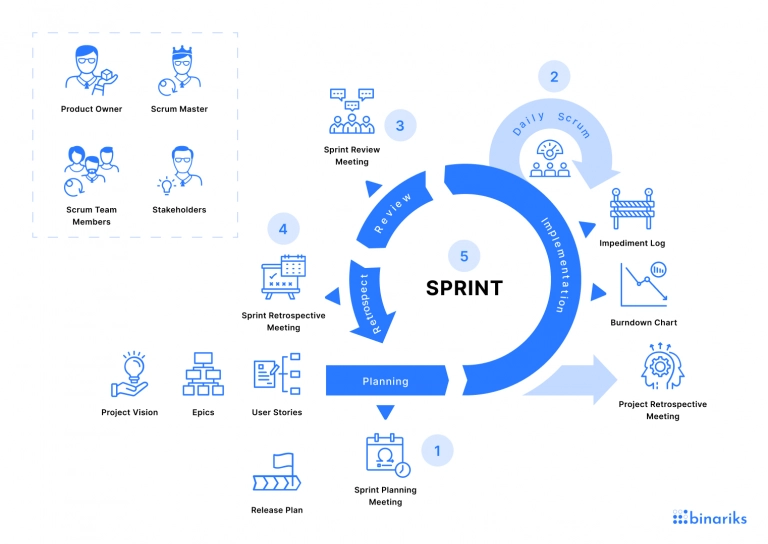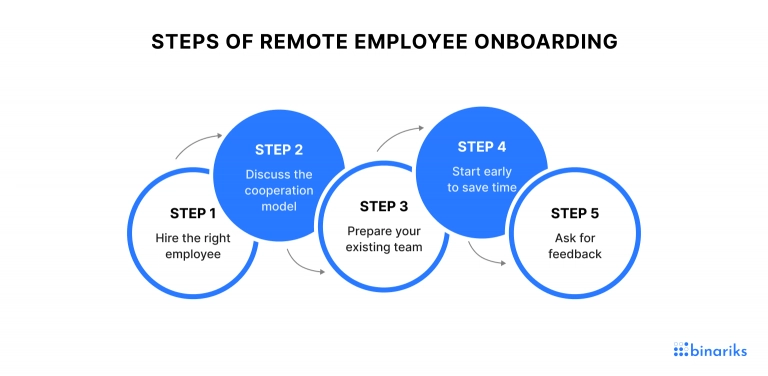It's no surprise that hiring a dedicated remote staff is a big trend, with 53% of the US workforce operating remotely . IT services are one of the most common fields to outsource due to the limited talent pool in the Western markets.
The remote software development model has numerous benefits, from cost-efficiency to performance boost, but you must set it up correctly. Remote engineers require slightly different approaches, tools, and management than in-house teams. Hence, you must establish transparent working processes and adopt best industry practices to make outsourcing work.
As an outsourcing tech company, Binariks has considerable experience managing development teams, and we are excited to share it here.
Plan and carry out a proper onboarding process
Onboarding is a multi-step procedure during which promising candidates turn into top-performing employees. Most companies that have been on the market for a while have established onboarding processes for candidates. If you cooperate with a software development outsourcing agency, they will probably also have an onboarding approach and may offer you some tried and tested procedures.
Starting cooperation with a remote employee or team considerably differs from in-house onboarding. You will have much less personal connection and need to develop detailed documentation to make up for it. Besides, the clarity of the onboarding process also becomes more critical since the distance between your managers and the hired employee creates additional obstacles.
As a rule, remote employee onboarding involves the following steps:
Hire the right employee
Everything begins with finding and choosing the most suitable candidates. Apart from checking the tech skills of the candidates, make sure you share the same corporate values. If you cooperate with a software development outsourcing company, they will offer you a few best options, but the final choice is yours.
Discuss the cooperation model and requirements
How to build a remote software dedicated team and onboard everyone successfully? Stay transparent from the start. Once you contract a person, discuss what you want from them and ask about their expectations (tasks, deadlines, salary, etc.). This information will become the roadmap for future cooperation.
Prepare your existing team
If you hire remote specialists to power your existing team, you must prepare both parties for collaboration. Redistribute processes, implement additional collaboration tools, and introduce small team-building activities. These steps should facilitate the onboarding of the new specialists and help everyone work together.
Start early to save time
You must arrange everything before the hired people start working. Provide them with access to the necessary tools, share documents, open a bank account, inform the accounting department, etc. If you cooperate with an outsourcing provider, they will do this for you.
Ask for feedback and be extra attentive when the project begins
Managing development teams is about keeping the finger on the pulse. Hence, you must ask the remote team members about their experience with your project. One-to-one meetings and anonymous feedback are the easiest ways to learn what people think. If someone is dissatisfied with their working conditions, you can use these findings to enhance onboarding and collaboration.
Gather a remote team of developers specifically for your product needs with us!
Select tools for managing software teams
Team building software allows multiple specialists to exchange information in real-time, redistribute tasks, discuss their concerns, and solve other issues. Managing a software development team in another location would be impossible without it. 79% of organizations participating in Gartner 's survey use collaboration tools, and 74% utilize storage/sharing software.
Some of the must-have tools include:
- Google Meet. Remote software development teams need a convenient tool for quick meetings with scheduling. Google Meet is perfect for this, especially if you use Gmail accounts.
- Google Drive. This web storage service has easy sharing and access features. You can create multiple folders to store documents, images, videos, and other content and choose who can view, comment, or edit it.
- Slack. Remote development teams widely use this platform for communication. Available for Windows, macOS, iOS, and Android, Slack enables users to create separate channels and dedicated spaces to discuss specific tasks or contact team members directly.
- Trello. With Trello, you can add tasks to boards and assign them to specific users for managing development teams. It simplifies planning and helps to redistribute tasks.
- Zoom. This tool is perfect for meetings with many participants since it supports up to 10,000 participants. Hence, Zoom is preferable for large companies and video conferences.
- GitHub. This code hosting platform facilitates team collaboration and, hence, remote development. Here, you can host your code and manage your projects.
- Jira/Asana. These tools are interchangeable since both are excellent options for time-tracking. While tech specialists utilize them to record the time spent on working issues, PMs access Jira or Asana to manage software development teams and plan the project scope.
Besides solving practical collaboration tasks, such software optimizes business processes. It's also a way to outperform companies that don't have as efficient remote development management tools as you. Hence, if you don't implement digital workplace technology, your performance will suffer in many aspects.
Set all processes
Even professional engineers won't show the best performance from the day first. To become smooth, remote development takes time and, most importantly, project management. Therefore, process setup is essential to successfully build a remote software dedicated team.
Most modern teams establish processes based on one of the Agile methodologies – in 70% of cases preferring Scrum . Yet you can also consider Extreme Programming, Dynamic Systems Development Method, Kanban Board, and Rapid Application Development as alternatives for managing software teams.
Here's a scheme visualizing software development processes in Scrum to guide you:

Generally, the planning stage is the task of the project manager responsible for the project. They know which methodology is the most suitable to launch a specific project or feature. Qualified PMs can also estimate the time necessary for each stage and assign tasks correspondingly.
Mind time difference
If you have a startup somewhere in Germany and hire dedicated remote staff in Ukraine, the time difference is one hour only. It means that you can be fully synchronous if you start at 10 AM and they start at 9 AM.
US companies usually face a more significant time difference when they hire a dedicated development team remotely. In case software engineers are in Asia, there might be no overlapping hours at all, which will inevitably affect the way of managing software development teams.
Hence, we recommend you do two things: Decide what time difference is acceptable before starting the cooperation. Do everything to eliminate its possible impact. Detailed planning and quality team building software can help track the progress and assign tasks regardless of the location and time differences.
Ensure perfect communication and nurture openness
Communication is crucial for the productive work of any team, no matter in-house or remote. Initially unnoticeable frictions often lead to significant conflicts making engineers want to change the team or quit their job. Besides, poor product communication disrupts working processes and harms the overall quality of the end product.
When managing a software development team, communication becomes even more challenging. Hence, you must put more effort into building relationships. Use these tips to melt the ice between teammates and make everyone enjoy working together:
Schedule meetings
Organize daily stand-up meetings and weekly progress reports to help everyone stay on the same page. This way, you will detect any miscommunications and development issues as soon as they arise.
Eliminate power distance
Besides discussing work-related issues, managers should know what happens in their team members' lives. It allows you to create a more personal connection and makes employees more loyal to their team and company.
Organize team-building activities
Even if you are far away, it doesn't mean you cannot treat your remote development team with a nice weekend or party. The money invested in organizing the event will pay off with increased team spirit and better communication.
Encourage healthy criticism
People joining a remote team may have different views on the same task and experience. If you let them speak openly and brainstorm, you are more likely to find an optimum solution to a problem. Besides, your management must remain open to feedback and be ready to change when the remote team expresses dissatisfaction.
If you need help implementing these tips, you may engage a human resource manager to arrange the necessary processes. Large software outsourcing companies like Binariks have skilled full-time HRs responsible for maintaining a positive working environment.
Reward your remote dedicated development team members
An autocratic management style is no longer relevant. Instead, you should praise, reward, and support your remote staff. Don't forget to say a good word when you are satisfied with what they do. Positive feedback inspires and instills the feeling that the completed work is meaningful. You can try some of the following ways to boost your team's morale:
- Start daily meetings with the achievements of the previous day. Focus on what your engineers have already completed before proceeding with the problems to solve.
- Always explain why you dismiss specific ideas and stay open to discussion. This way, people will know you value their opinion and will willingly offer something again the next time.
- Make one-to-one meetings a pleasant experience, not a punishment. Be sure to mention how each person contributes to the project's overall success.
Besides positive feedback, you can also nurture staff with freebies. For example, provide everyone with corporate gifts after the project reaches a specific stage. Or you can supply a team with free visits to a gym, swimming pool, educational courses, etc. Cash bonuses are another way to reward the remote team. Additional payment is an excellent incentive when people work overtime to troubleshoot an urgent issue.
Why are rewards so critical for managing software development teams? It has been found that engaged employees are 43% more productive than others . Therefore, happy software engineers will generate much better results than unmotivated ones. Yet, at the same time, you must be careful and avoid spoiling your staff with gifts given without any reason. People will get used to bonuses and start taking them for granted, not as a reward.
Stimulate people to stay on your product
Since the demand for qualified software engineers is high, many companies will try to lure your specialists away. Hence, employee retention is an essential part of managing software development teams. If you don't find ways to keep people on your project, you may fail to meet deadlines or launch the product altogether.

Some of the listed best practices for managing software teams should already help you with retention. But there are some other highly effective approaches to adopt, such as:
Leave space for creativity
Product development is a creative process as there may be numerous solutions to a single problem. Experienced engineers like it when they can bring something innovative into the project. Challenges and freedom and choice make their work more engaging, and, as a result, they are less likely to switch projects.
Have you heard that Google allows employees to spend 20% of their working time on what they think can benefit the company? This policy has led to the appearance of AdSense and Google News as side projects.
Clarify responsibilities and roles
You must clearly define which team member is responsible for a particular task. It's also important to set deadlines after discussing them with the related individuals. Then, everyone will know what they are responsible for and will concentrate on their piece of work. Such clarity makes the software development process smoother and minimizes conflicts between workers.
Offer professional growth
Communicate to everyone on board that they can get career advancement once they have the necessary skills or knowledge. You can even involve an HR department to create a career roadmap for every person, be it a senior engineer or marketer. When people know they can get a better position soon, they are unlikely to change companies. It also motivates them to work harder and gain the missing experience.
Final thoughts
Managing development teams remotely is not much more complicated than in-house. It just requires a slightly different approach, collaboration tools, and quality communication.
Things get even easier if you outsource building a software engineering team to a third-party provider like Binariks. We can do recruitment and onboarding for you to assemble a dedicated team fully focused on your project. Binariks also handles administrative and HR routines leaving our customers with only strategic decisions. We hire experts with experience in all top industries, from web platforms for hospitals to marketing solutions .
View more completed projects here and contact us to hire remote engineers for yours.
Share

